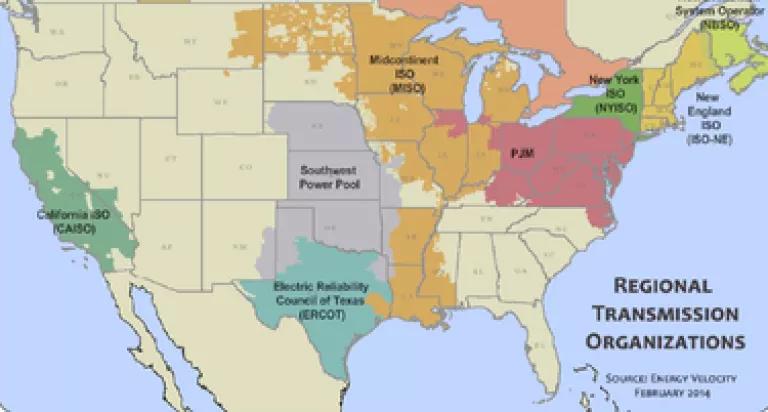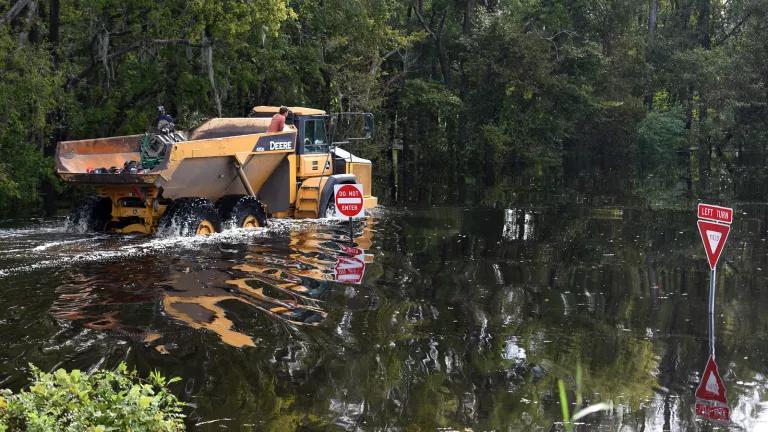The Polar Vortex and the Power Grid
What really happened and why the grid will remain reliable without soon-to-retire coal plants

This post is co-authored by John Moore and Allison Clements.
In the grip of the “Polar Vortex,” much of the nation experienced an extremely cold winter. The good news is that despite record electricity demand and some of the coldest weather in 20 years, power companies and grid operators kept the lights and heat on. Yet some observers are now claiming that this past winter’s experience casts doubt on whether the power system can cope without the aging coal-fired power plants that are slated to retire over the next couple of years in the face of competitive pressures.
Fortunately, the nation’s major grid operators – the entities charged with maintaining the power grid’s reliability and keeping the lights on – disagree. This fact sheet explains what happened on the grid during the Polar Vortex and clears up misconceptions about what the experience means for both future extreme weather conditions and implementation of the US EPA’s carbon pollution standards.
Q: It’s been reported that many old coal plants that are slated to retire next year were needed during this winter’s extreme cold snaps. For example, American Electric Power (AEP), one of the country’s largest power companies, reported that 89% of its coal plants scheduled for retirement ran during the Polar Vortex. Why did so many old coal plants run this winter?
Old coal plants ran so heavily because an unusual number of other plants were out of service during the Polar Vortex for a variety of exceptional weather-related reasons that are being fixed going forward. Coal plants slated for retirement won’t be needed when these exceptional outage problems are fixed.
Most of the plants that were out of service were unavailable because of operational and mechanical problems like frozen coal stockpiles, boiler tube failures, and faulty ignition. Some plants, for example, failed to start up in the extreme cold after being off line for months. (By the end of January, when we experienced another extreme cold spell, more plants had recovered and were running normally.) Grid operators are now working on corrective measures to avoid these surprises, including requiring plants to test and verify their operational capability during the cold winter months. These tests include a “weekend check” requirement to assure that plants won’t have trouble starting up again after a prolonged break. Grid operators are also evaluating additional financial incentives to reward plant operators that deliver higher performance levels.
Cold weather conditions also revealed problems with natural gas procurement practices, even though sufficient gas supply was available throughout the period. In addition, a glitch in the power and gas markets kept some gas-fired generators from obtaining sufficient fuel on high-demand days – power markets in some regions declare their next-day needs too late in the day for gas markets to respond. The Federal Energy Regulatory Commission (FERC) and the grid operators responsible for maintaining a reliable electric grid are working to fix this problem before next winter.
Q: So, in light of the stresses during this winter’s Polar Vortex, aren’t these retiring coal plants really needed next year?
Not according to PJM, the nation’s largest grid operator with more than 180,000 megawatts (MW) of power plant capacity throughout the Mid-Atlantic and Midwest. Like other regional grid operators, one of PJM’s core responsibilities is to ensure through future planning that sufficient power generation, transmission lines, and other grid resources will be available to maintain reliability and keep the lights on. After a thorough assessment of reliability concerns, PJM has determined that all nine of the soon-to-retire AEP plants in its region (accounting for about 5,400 MW of capacity), plus thousands of megawatts' worth of other power plants can cease operations without causing any grid reliability problems. Reflecting on the Polar Vortex in April, PJM informed FERC that it will have more than enough power to meet reliability needs after accounting for all planned retirements from companies across the region.
PJM secures necessary power supplies through an annual auction that runs three years into the future. As a result, PJM has determined that its needs through 2017 will be met by existing coal, gas, and nuclear power plants supplemented by nearly 19,000 MW of new power generation, energy efficiency resources, and power imports from neighboring regions of the country, plus over 12,000 MW of "demand response."[1] The combination of resources will more than offset the approximately 15,000 MW in expected regional coal plant retirements, leaving PJM with about 20 percent more capacity available than needed to meet projected demand.
Q: What about other regions? For example, I’ve heard that the grid operator Midcontinent Independent System Operator (MISO) is worried about insufficient power capacity in the future – is that true?
MISO operates the grid in all or part of 15 states in the Midwest and South. On April 15, MISO reported to FERC that it has more than enough power capacity and demand response resources to meet this summer’s and next winter’s projected demand. Similar to PJM, new plants, energy efficiency investments, and other measures are replacing plants slated for retirement. Looking ahead to winter 2015/2016 and through the end of 2016, MISO and its participating states believe that the region is very close to meeting its power supply requirements. MISO’s analysis is ongoing, and more power may be available from the southern part of MISO (Arkansas, Mississippi, Texas, and Louisiana), which has extra capacity, and from imports from the neighboring RTO, the Southwest Power Pool.
Q: How can we be sure the grid will stay reliable in cold weather conditions after upcoming compliance deadlines arrive for new environmental protection standards?
Grid operators are planning to meet their capacity needs (including during hot and cold snaps) taking new environmental rules into account, including for example US EPA’s Mercury and Air Toxics Standards (MATS). Acknowledging that a variety of factors – not the least of which is low-cost natural gas – create the potential for additional coal plant retirements and that work needs to be done to address fuel supply issues, none of the grid operators has told FERC or Congress it supports a delay of the MATS standard or of the forthcoming carbon pollution standards. In fact, some of the operators have commented that it does not make economic sense to pour money into retrofitting and retaining older, less reliable plants, because that diverts investments away from newer and more reliable plants.
Q: Can we be sure the coordination issues between natural gas markets and power markets will be fixed?
FERC and the grid operators started addressing these issues before the Polar Vortex began, and they have opened related rulemaking procedures in all relevant regions. Planned changes include better coordination of the daily natural gas and electricity markets to make sure that gas can be delivered when needed, and changes to make it easier for gas-fired plants to run on oil during any gas supply shortages that do occur. This dual-fuel capability helped many plants in New England to operate successfully in January and February (although burning oil instead of gas increases pollution and should be viewed only as a remedy of last resort).
Q: Did wind power help or hurt during the Polar Vortex?
Wind power contributed to the grid’s reliability during this winter’s cold weather. In Texas and the Mid-Atlantic/Midwest, wind energy supplied thousands of megawatts of power during critical times, helping to temper some price spikes and avoid blackouts. The California Independent System Operator, which operates most of California’s grid, told FERC at an early-April meeting on cold weather operations that “renewables helped to get us through the winter.” Likewise, the New England ISO recently told the House Energy & Commerce Committee that renewable energy resources “were an important part of the energy mix” during the past winter. As wind power continues to expand throughout the country, it is becoming more valuable to grid operators during periods of winter peak demand. Throughout the various cold snaps in New York, the nearly 1,400 MW of wind in the NYISO market performed very well, contributing low cost emissions free power during high demand.
Q: How did energy conservation help during the cold weather? Did utilities force people to cut back on home heating during the Polar Vortex?
Energy efficiency and demand response programs[2] helped the grid get through this winter, but no customers were ordered to cut back. Manufacturers, businesses, and other large customers in the Mid-Atlantic and Northeast regions responded to demand response financial incentives by voluntarily reducing peak electricity use to the tune of 3,000 MW during the Polar Vortex. As the New England ISO recently reported, demand response resources “performed well and were a valuable part of maintaining reliability during the winter season.” All regions are now evaluating ways to expand the amount of demand response available to meet winter peak demand needs.
Q: Are all these retirements going to cause sticker shock in coming electric bills?
There’s no getting around the fact that we use more power when it’s extra cold. So it’s no surprise that power bills went up during this extreme winter. It is also true that high gas demand led to temporary regional gas price spikes, which translated to higher energy prices for short periods during the extreme cold. Though the peak prices paid by utilities were high, the final cost felt by consumers was tempered by the fact that these high prices were temporary and some retail rate structures shield residential consumers from these costs. Going forward, FERC and grid operators are now working to reduce gas price spikes through better market rules and other solutions. Also, gas prices are lower overall on an annual basis than in the past.
Q: How can energy efficiency and renewable power help meet peak power needs and keep bills down?
The cold weather events highlight the important role that energy efficiency can play in meeting peak power needs and holding down bills. Grid operators in the Mid-Atlantic (PJM) and Northeast (ISO-NE) have used efficiency in their electricity markets to reduce electricity needs by several thousand megawatts. Unlike coal and natural gas plants, energy efficiency performs well in all weather conditions while costing less than half as much as building new generation. Renewable energy offers zero-cost fuel no matter the weather – and some renewable resources perform at very high levels during the winter months when gas supply is under the most pressure. Expanding these resources is the best way to meet our energy needs – both on an every-day basis and in winter and summer extremes.
You can find more information on how grid operators plan for higher-than-expected electricity demand here.
[1] See PJM, 2016/2017 RPM Base Residual Auction Results, at 1. Demand response programs allow industrial, commercial, and even residential customers to enter contracts to cut their electricity use for short periods in exchange for a bonus payment, if the grid operator determines there is too much demand at a particular time. Demand response programs contributed to grid stability during the Polar Vortex.
[2] See note 1, above.




